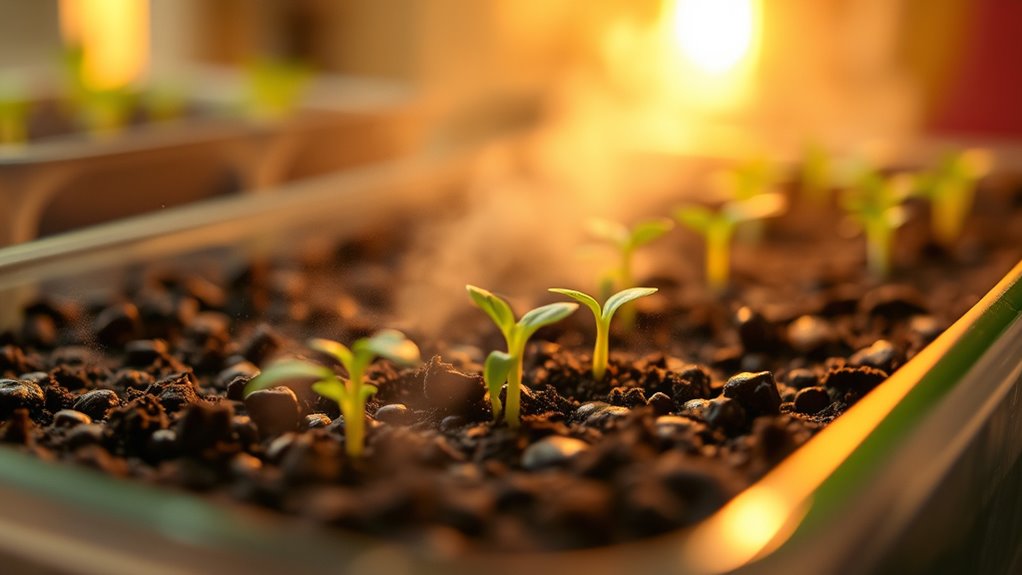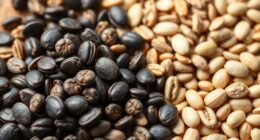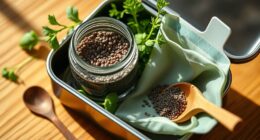To germinate seeds faster, keep the soil consistently moist but not soaked, using gentle watering or spray bottles. Cover your seeds with plastic or humidity domes to maintain ideal humidity and temperature. Use a nutrient-rich seed-starting mix formulated for quick sprouting, and avoid disturbing the seeds during germination. Monitoring moisture levels and providing warmth can boost sprout speed. Continue exploring these tips to get seedlings up and growing more quickly than you might expect.
Key Takeaways
- Keep soil consistently moist with gentle watering or humidity covers to promote rapid germination.
- Use a warm, well-lit environment to accelerate seed sprouting and early growth.
- Provide a nutrient-rich seed-starting mix to support quick root development.
- Cover seeds with clear plastic or humidity domes to maintain high humidity levels.
- Avoid disturbing seeds during germination to prevent delays and ensure faster sprouting.

Are you enthusiastic to start your garden sooner? If so, understanding how to optimize seed germination is key. One of the most effective ways to speed up the process is by paying close attention to seedling nutrition and watering techniques. Proper seedling nutrition provides the essential nutrients young plants need to develop quickly and healthily, while precise watering ensures they stay hydrated without drowning or stressing the roots.
When it comes to seedling nutrition, you don’t need to overcomplicate things. Using a balanced, water-soluble fertilizer or seed-starting mix rich in essential nutrients like nitrogen, phosphorus, and potassium will give your seedlings a strong foundation. Make sure to choose a formulation designed specifically for young plants, as they’re more sensitive to nutrient imbalances. Incorporating these nutrients early on encourages faster root development and vigorous growth, helping your seedlings break dormancy and establish themselves sooner. Keep an eye on the health of the leaves and stems; any yellowing or stunted growth might indicate a need for additional nutrition. Remember, though, that too much fertilizer can harm delicate seedlings, so follow the instructions carefully.
Watering techniques play a crucial role in germination speed. Consistent, gentle moisture is vital because seeds need to stay moist but not soaked. Overwatering can lead to fungal diseases or root rot, while underwatering slows down germination by causing seeds to dry out. The best approach is to water lightly and frequently, ensuring the soil or seed-starting medium remains evenly moist. Using a spray bottle or a gentle watering can allows you to control the flow and prevent disturbing the seeds. Covering your containers with clear plastic wrap or a humidity dome can help maintain consistent moisture levels, speeding up germination. Once the seeds sprout, gradually reduce humidity but continue to keep the soil moist. Proper watering techniques also involve checking the moisture level regularly; insert a finger into the soil about an inch deep. If it feels dry, it’s time to water again. Avoid letting the soil dry completely or stay waterlogged, as both conditions can delay germination and weaken seedlings.
Frequently Asked Questions
Can Light Exposure Speed up Seed Germination?
Yes, light exposure can speed up seed germination. The light spectrum, especially blue light, stimulates the process and helps break seed dormancy. When you expose seeds to the right light conditions, it signals them to start sprouting faster. Keep in mind that some seeds require darkness to germinate, but for those that benefit from light, providing consistent, appropriate light exposure accelerates germination and leads to healthier seedlings.
Is It Better to Soak Seeds Before Planting?
Soaking seeds before planting can help speed up germination, especially for seeds with tough coats. This process, similar to seed scarification, softens the seed coat and encourages sprouting. For seeds requiring specific conditions, like cold stratification, soaking combined with proper pre-treatment can improve success rates. Just make sure you don’t over-soak, as it may cause rot. Overall, soaking is a useful step for many seed types to promote quicker germination.
Do Seed Coatings Affect Germination Speed?
Think of seed coats as nature’s armor, sometimes guarding seeds too well. Seed coatings influence germination speed through seed coat permeability, controlling water absorption and gas exchange. If the coating is too tough, it delays germination, requiring dormancy breaking techniques like scarification or soaking. By gently breaking or softening these coatings, you help seeds wake up faster, turning a sluggish start into a sprouting sprint.
Can Temperature Fluctuations Improve Germination Rates?
Temperature fluctuations can boost germination rates by breaking seed dormancy and encouraging growth. You should monitor soil moisture carefully, as consistent moisture helps seeds respond to temperature changes. Alternating warm and cool periods signals seeds to sprout, but avoid extreme swings that could dry out the soil or harm seeds. This natural variation can markedly improve germination speed, making your planting process more efficient and successful.
How Does Seed Age Influence Germination Speed?
Seed age considerably influences germination speed because older seeds often develop seed dormancy, which delays sprouting. Younger seeds tend to germinate quicker since they haven’t accumulated dormancy factors. Additionally, genetic factors play a role, as some seeds are naturally programmed to germinate faster or slower. To boost germination, use fresh seeds and consider pre-soaking or scarification to break dormancy, ensuring faster and more uniform sprouting.
Conclusion
By trying these proven tips, you can speed up your seed germination and enjoy flourishing plants sooner. Some believe soaking seeds or using heat enhances sprouting, but evidence shows consistent methods matter most. Don’t fall for quick fixes that might harm your seeds—trust proven techniques, stay patient, and you’ll see results. Remember, nature’s timing is often slower, but with a little effort, you’ll be rewarded with healthy, thriving plants in no time.









